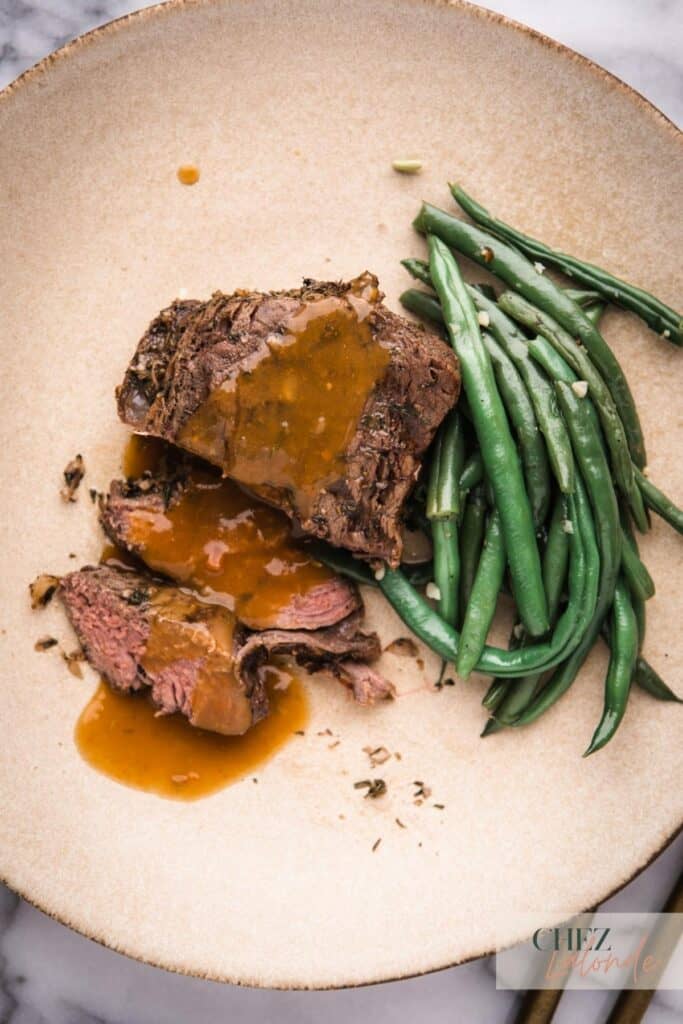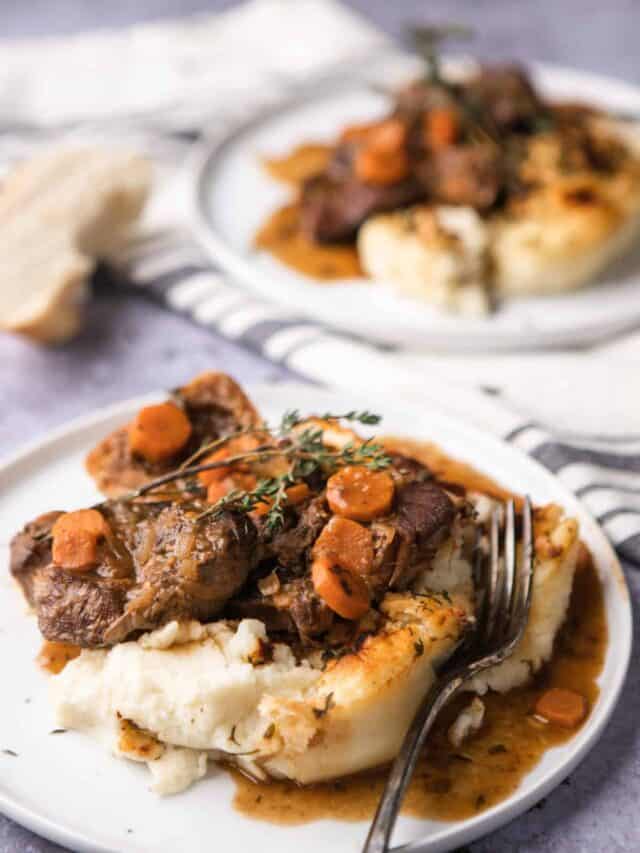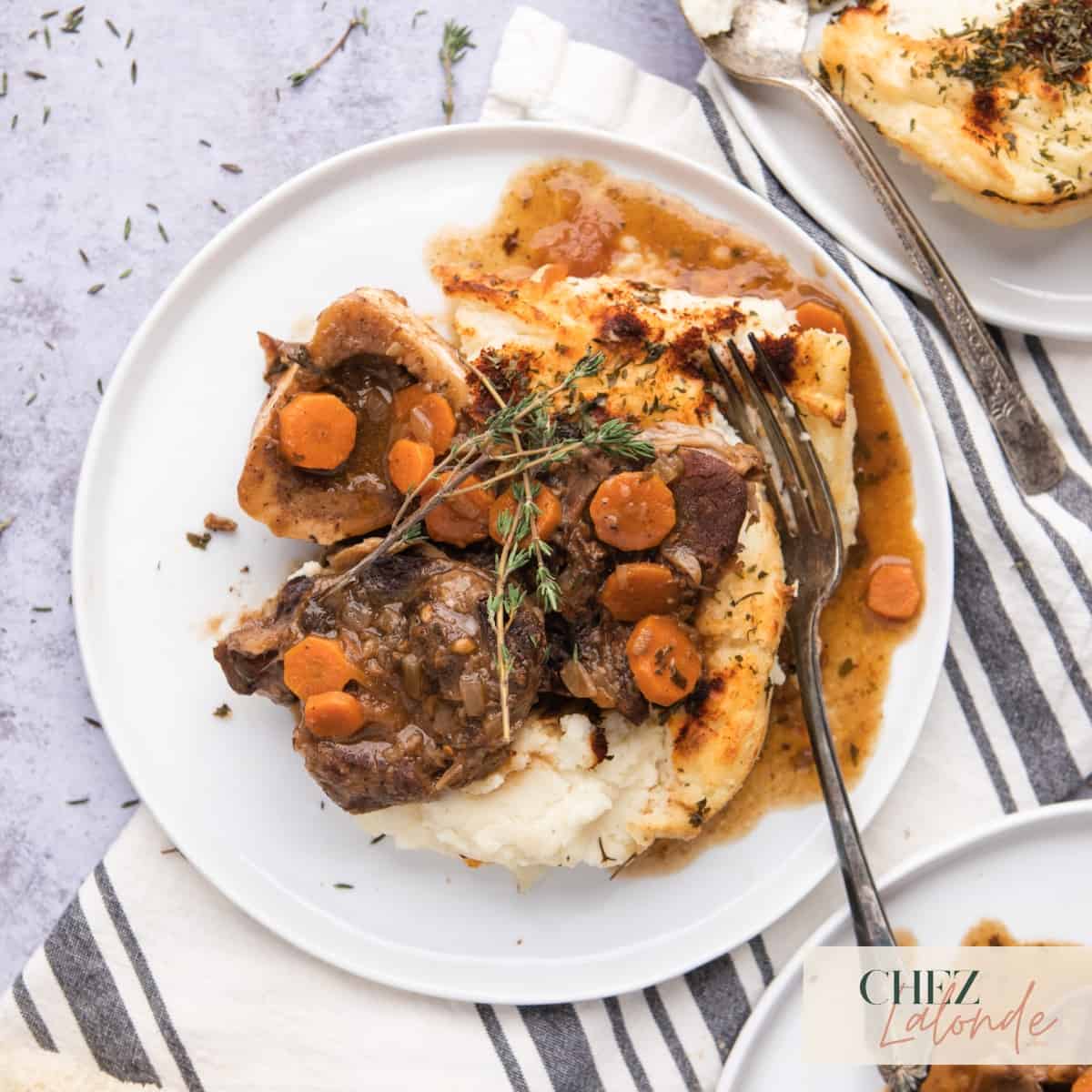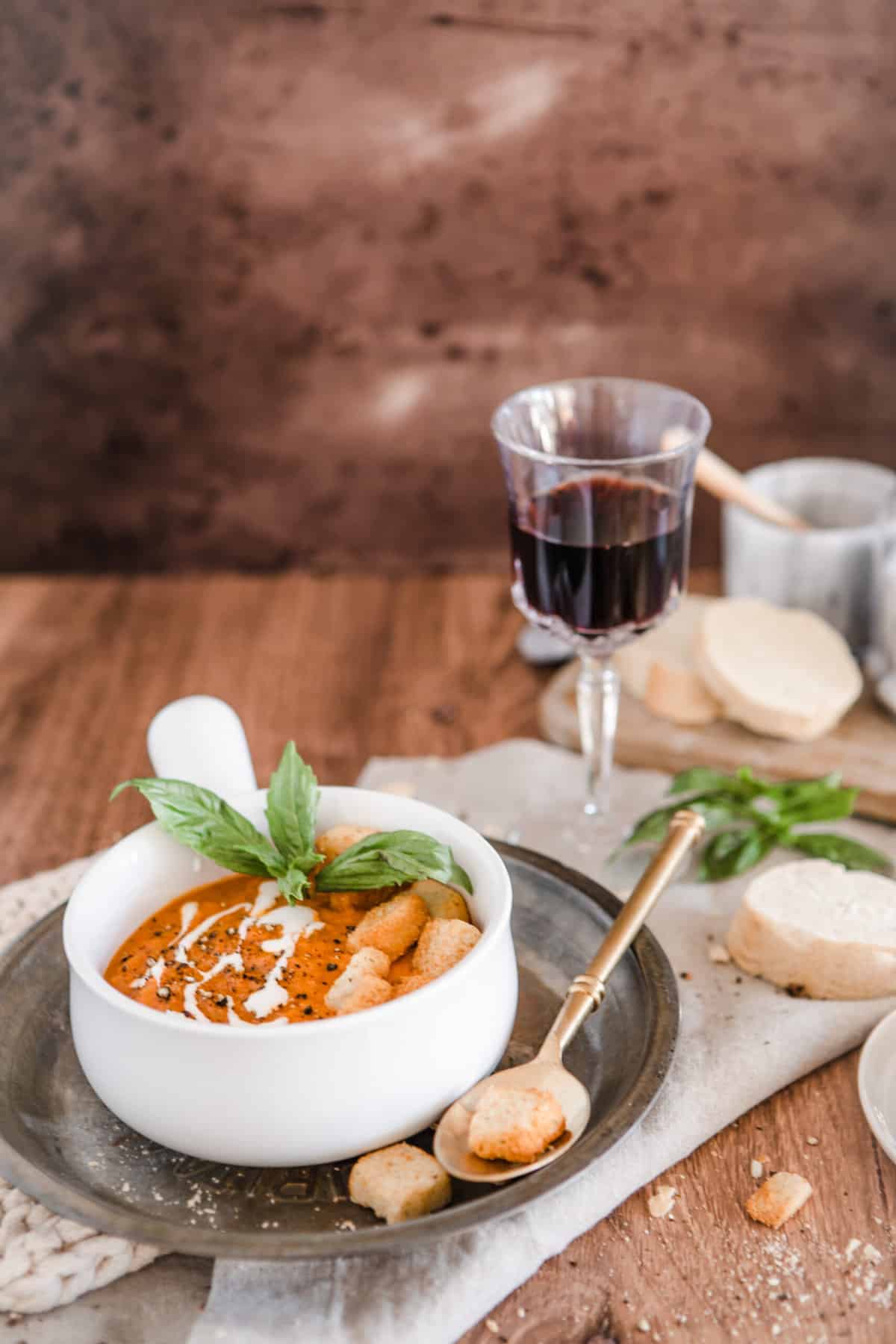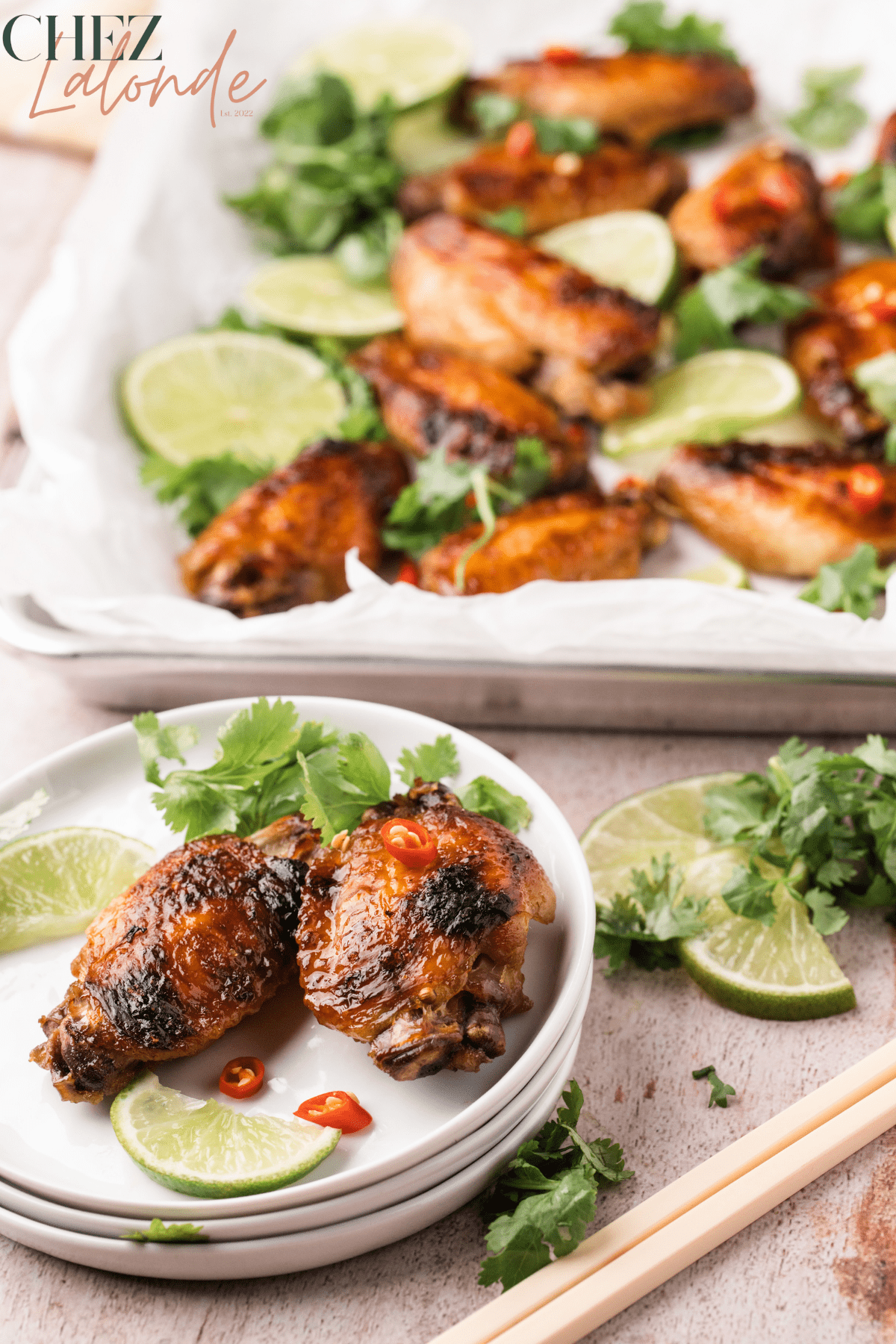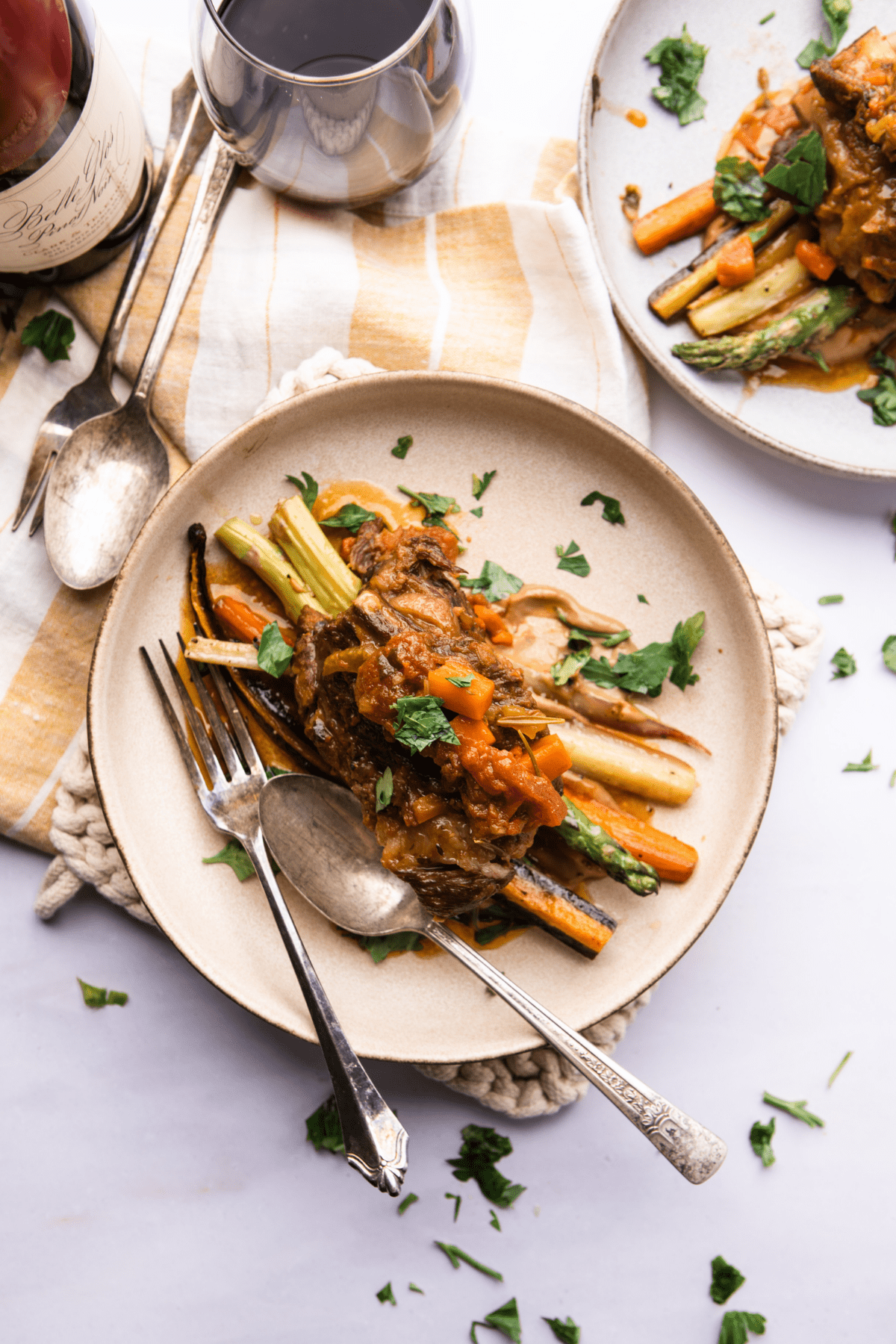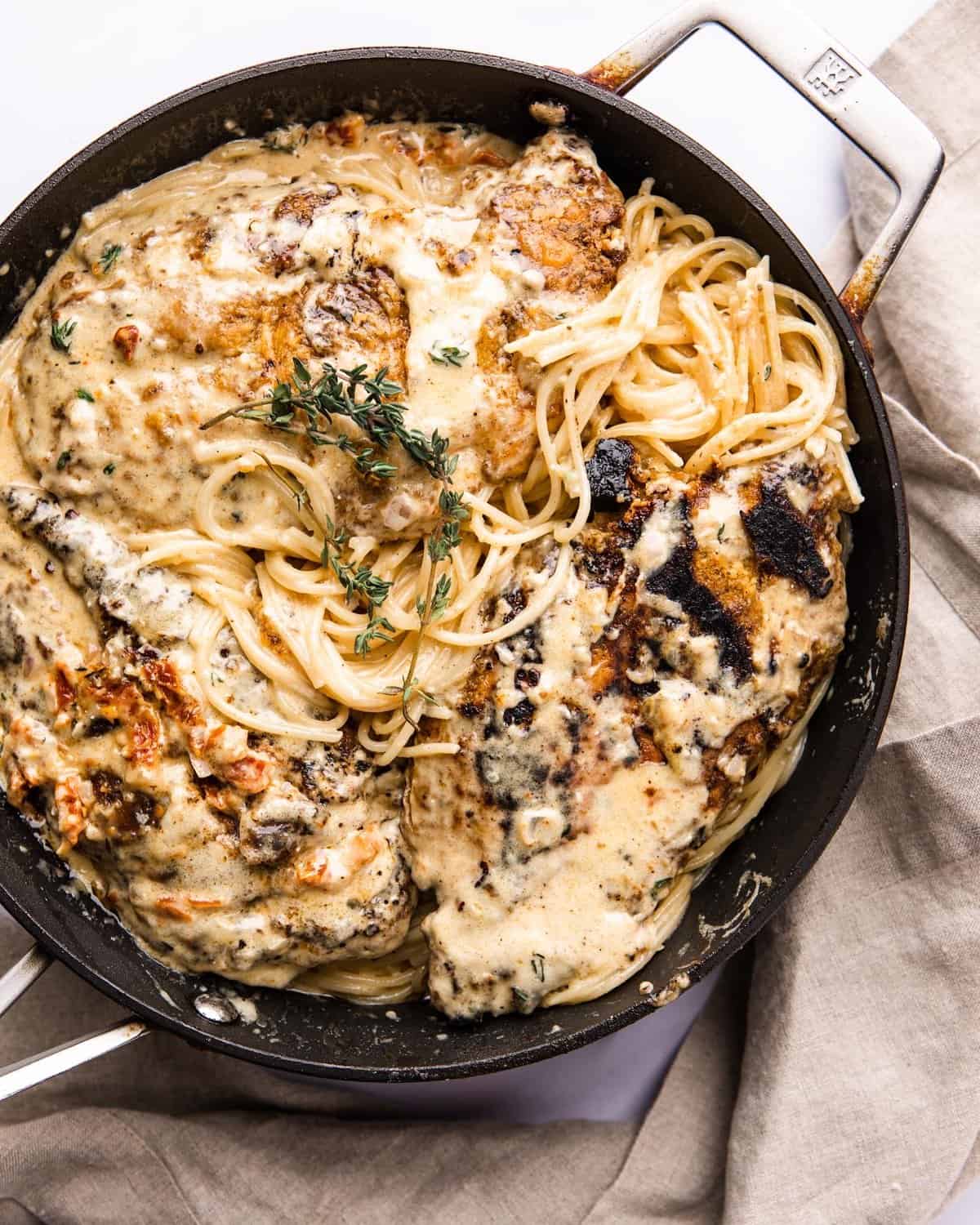Sous Vide Bourbon Vanilla Crème Brûlée In Mason Jars
This Sous Vide Bourbon vanilla crème brûlée in Mason jars is a classic French dessert that has become increasingly popular recently. This delicious traditional dessert is made by cooking a rich custard base in a water bath using the sous vide technique. The result is a creamy, velvety texture perfectly complemented by a crisp layer of caramelized sugar.

Disclaimer Notice: This website contains affiliate links. If you make a purchase through these links, I may earn a commission at no extra cost to you. I only endorse products or services I believe will be valuable to my readers. I appreciate your support.
I used to swear by the traditional baking method for crème brûlée, but there’s been no turning back since I discovered the Sous Vide technique. It’s foolproof and perfect for getting your kids involved too. Say goodbye to the stress of heating cream and accidentally scrambling your egg yolks. With Sous Vide, it’s as simple as mixing every ingredient, pouring your custard mixture into mason jars, and letting the temperature-controlled water bath work its magic for one hour and fifteen minutes. The best part? It’s impossible to overcook, leaving you free to focus on other things.
So grab your ingredients and apron, and let’s embark on this exciting Sous Vide dessert adventure together!
Recipe Snapshot
EASE: Super easy, just mix the ingredients and Sous Vide.
PROS: It’s a classic French delicacy.
CONS: Absolutely none
WOULD I MAKE THIS AGAIN? For sure! It is perfect for a dinner party.
What is the meaning of crème brûlée in French?
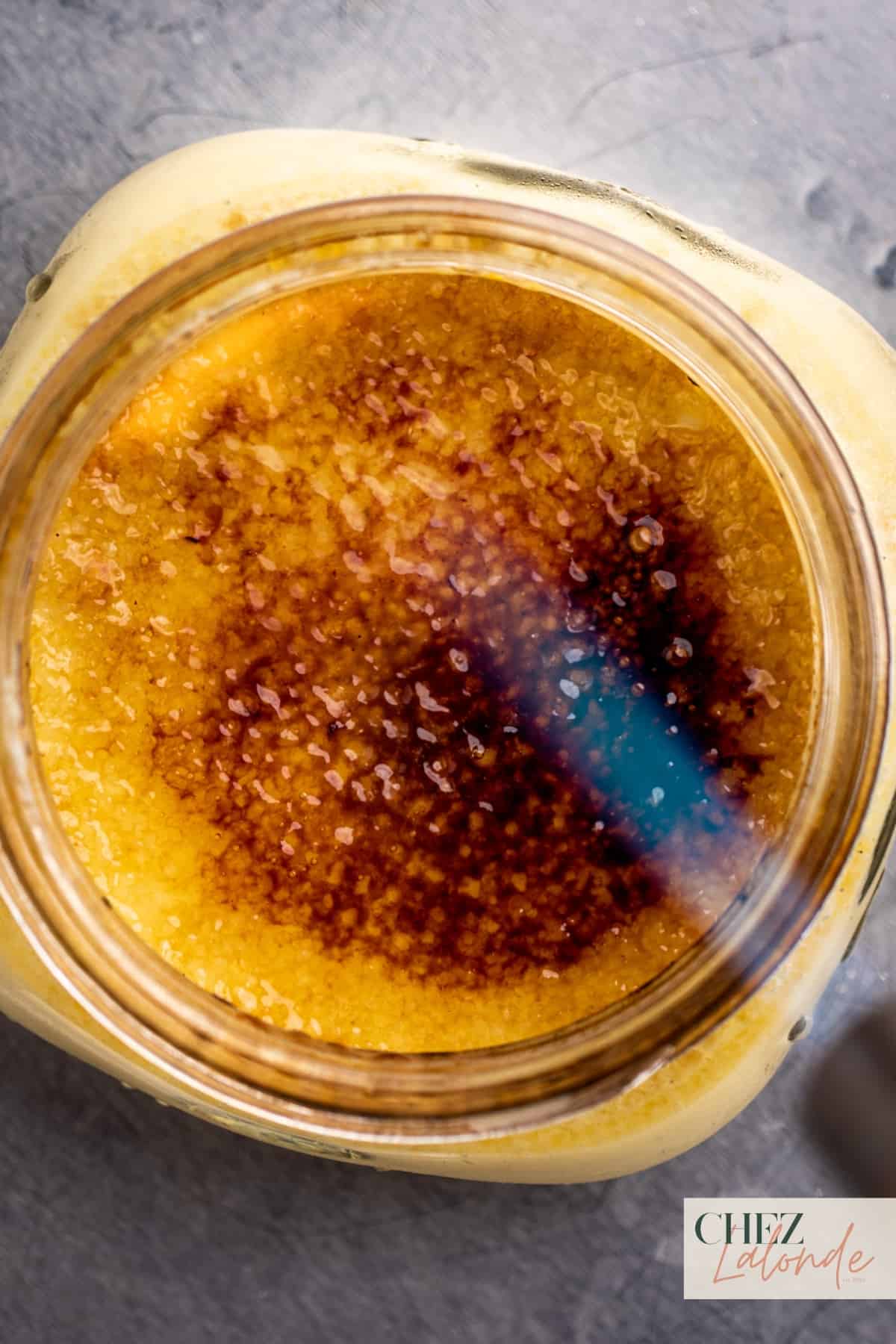
Did you know?
“Crème brûlée” is pronounced as “krem broo-lay” in French.
In French, “Crème” means “cream,” and “brûlée” means “burnt” or “scorched.” The name refers to the dessert’s signature caramelized sugar crust that forms on top when torched. It creates that signature crispy and caramelized sugar layer on the custard.
What is Sous Vide precision cooking?
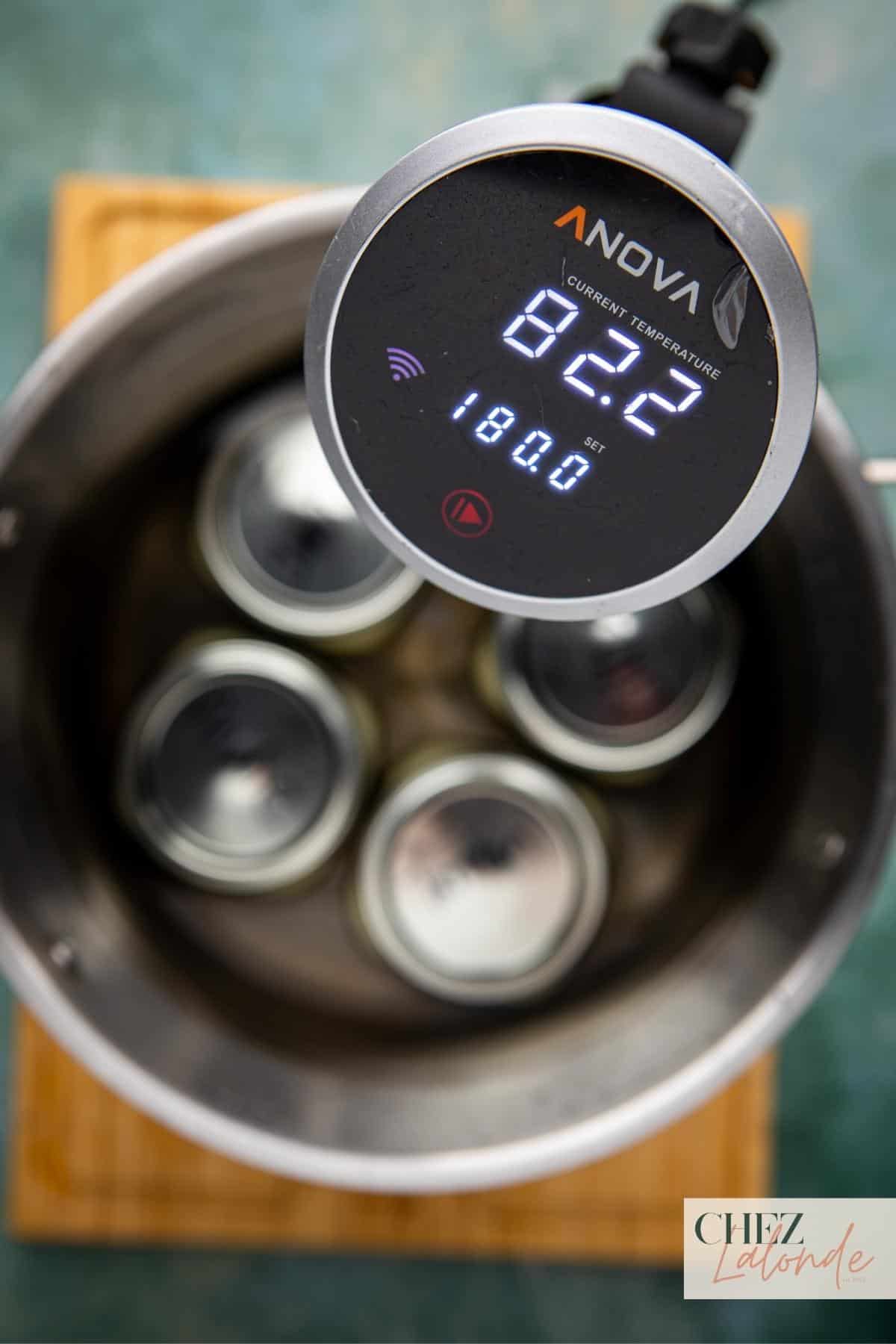
Sous Vide precision cooking is a culinary technique from France, where food is cooked in a precisely controlled water bath at a consistent temperature for an extended period. The term “precision” emphasizes accurate temperature control, resulting in evenly cooked dishes with exceptional tenderness and flavor. This method offers versatile applications, allowing for cooking tough cuts of meat, significantly reduced vanilla extract infusing time, pasteurizing eggs, and more. Sous Vide has become increasingly popular in home cooking, and you can explore my Sous Vide Filet Mignon post for further insights into this cooking technique.
Why is it a good idea to make this dessert using the Sous Vide cooking method?
The sous vide method is ideal for making crème brûlée because it allows precise temperature control, which is essential for achieving the perfect texture. By cooking the custard at a low temperature for an extended period, the proteins in the eggs coagulate slowly, resulting in a smooth and silky texture. Additionally, the sous vide method eliminates the risk of overcooking or scrambling the custard, which can happen with traditional methods.
What is the difference between Sous Vide and traditional baked crème brûlée?
Sous Vide and traditional baking methods can produce an exceptional French dessert. There is no absolute right or wrong approach. Each method has its pros and cons. Sous Vide takes longer, while traditional baking requires a more advanced culinary skill set and careful monitoring. The choice ultimately depends on personal preference.
Allow me to provide a detailed breakdown of the differences between these two methods, enabling you to understand better and decide which way suits you best.

Sous Vide Method:
You would need to fill the custard mixture in jars, seal and submerge them in a precise control temperature water bath at 180F/ 82C and cook for 1 hour and 15 minutes. The consistent temperature results in a smooth and velvety custard that is guaranteed never to overcooked. You can pre-made your crème brûlée and refrigerate it for 3 to 5 days. This is a perfect option if you are planning for a dinner party or gift this as a gift for your friends and family.
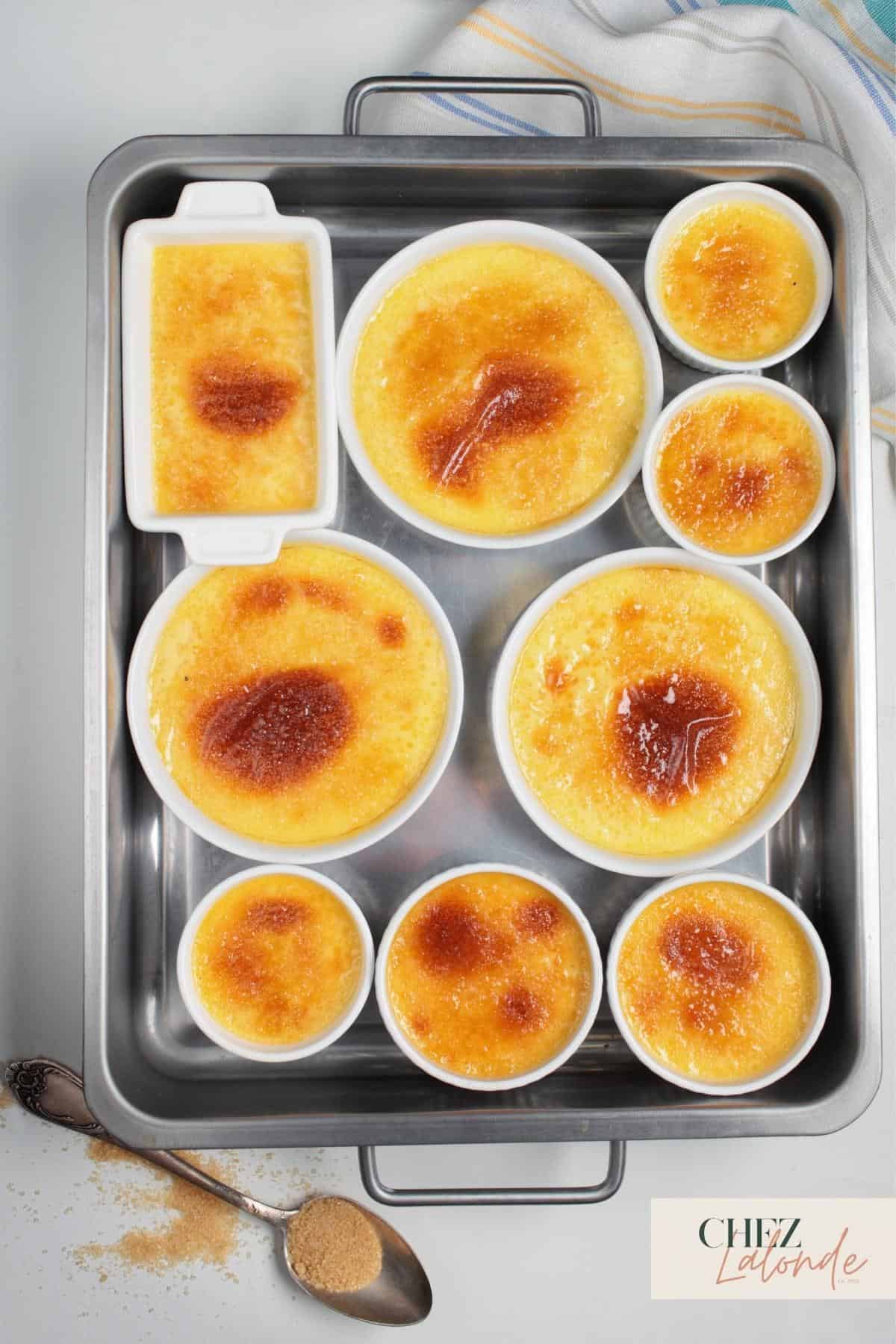
Traditional Baking Method:
The traditional method can be challenging for beginners without basic baking knowledge. It involves boiling cream, infusing vanilla bean, and carefully tempering egg yolks to avoid scrambling. Pouring the custard into shallow ramekins and baking in a water bath at 300°F for 20 minutes is required. However, there’s a risk of water spilling into the ramekins if not handled carefully. Overcooking can lead to a denser and harder custard. Experience and skill are necessary for successful execution.
What’s the difference between Spanish flan and French crème brûlée?
While both desserts are custard-based and offer a delightful sweet treat, Spanish flan tends to have a lighter and more pudding-like texture. At the same time, French crème brûlée is known for its luxurious and creamy mouthfeel combined with the delightful caramelized sugar crust on top. Here they differ in a few key aspects:
Spanish Flan:
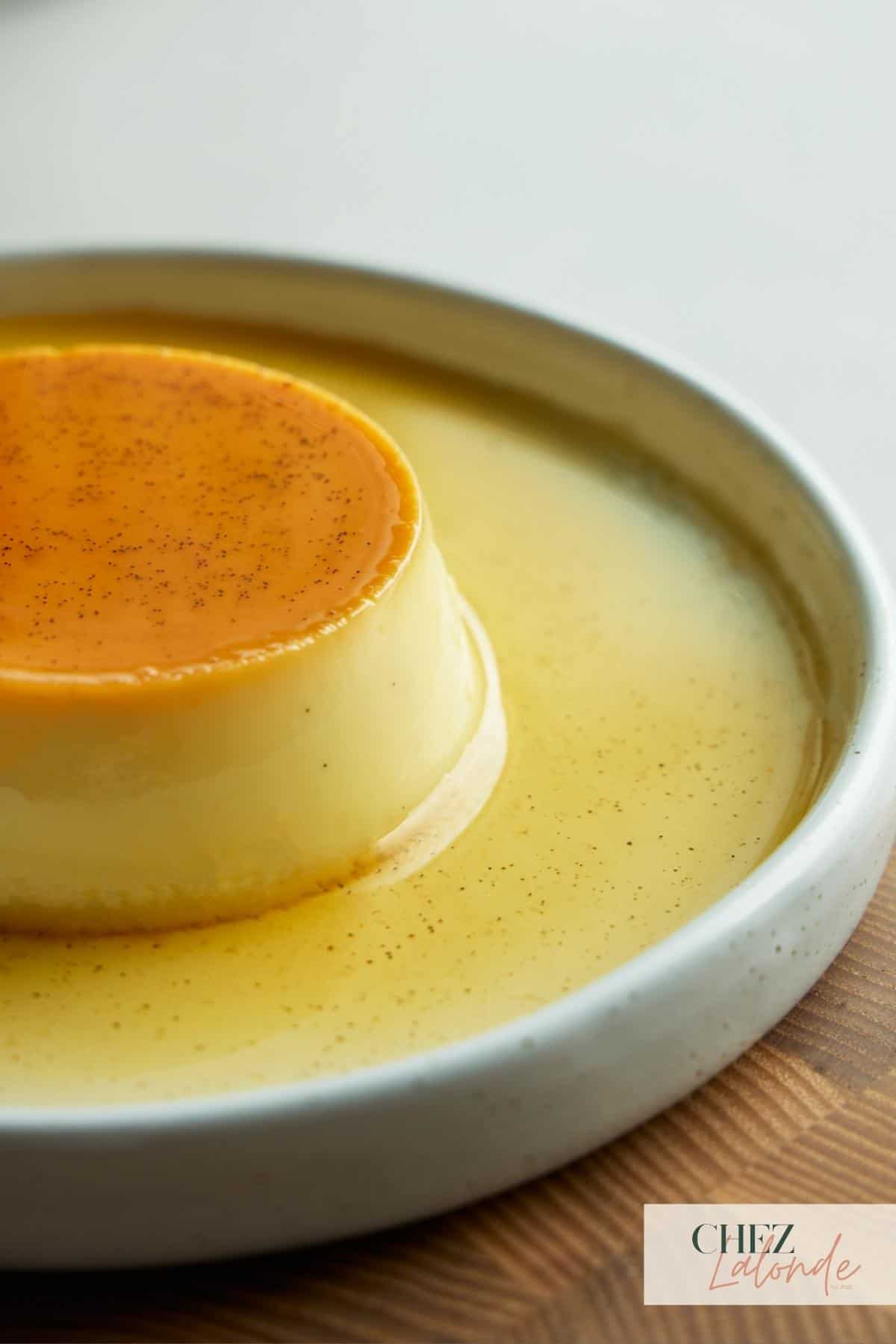
- Texture: Its primary ingredient is condensed milk. It has a smooth and silky texture. Similar to dense pudding with a slightly jiggly consistency.
- Caramelization: It creates a layer of caramel sauce at the bottom of the flan by melting sugar and then poured into the mold before adding the custard mixture.
- Flavor: It has a more subtle vanilla or citrus zest flavor.
- Serving Style: Spanish flan is usually served inverted with the caramel sauce drizzled over the top when unmolded.
French crème brûlée:
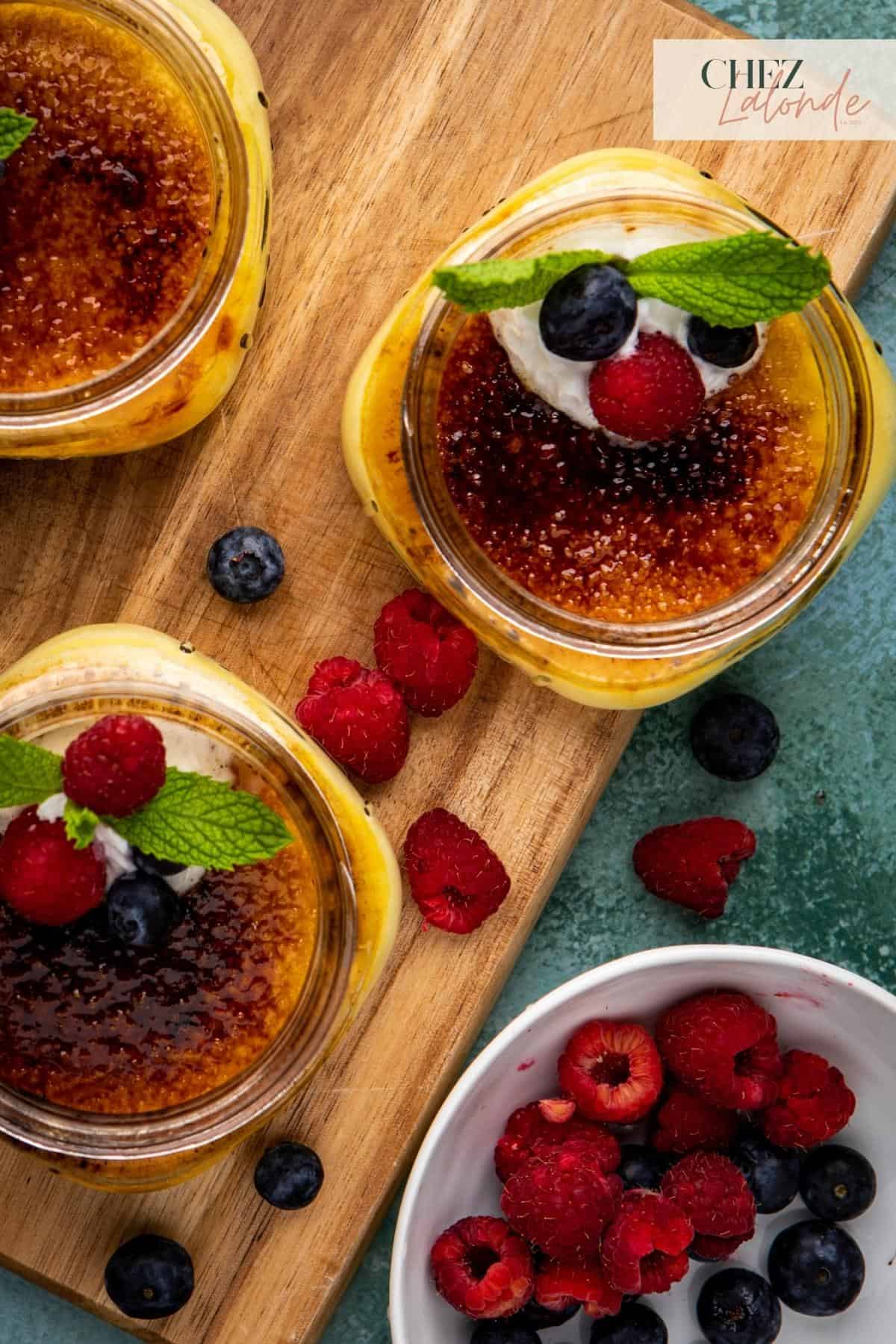
- Texture: Its central ingredient is heavy cream. It has a creamier, more velvety, and rich custard texture.
- Caramelization: It features a thin sugar layer sprinkled on the cooked custard mixture and torches it to form a crisp caramelized crust.
- Flavor: It has a more pronounced vanilla flavor and generally infuses real vanilla beans during cooking to enhance the rich flavor.
- Serving Style: French crème brûlée is served in individual ramekins or jars, with the caramelized sugar crust intact and providing a delightful crackling experience.
You only need 6 Key Ingredients to make this dessert:
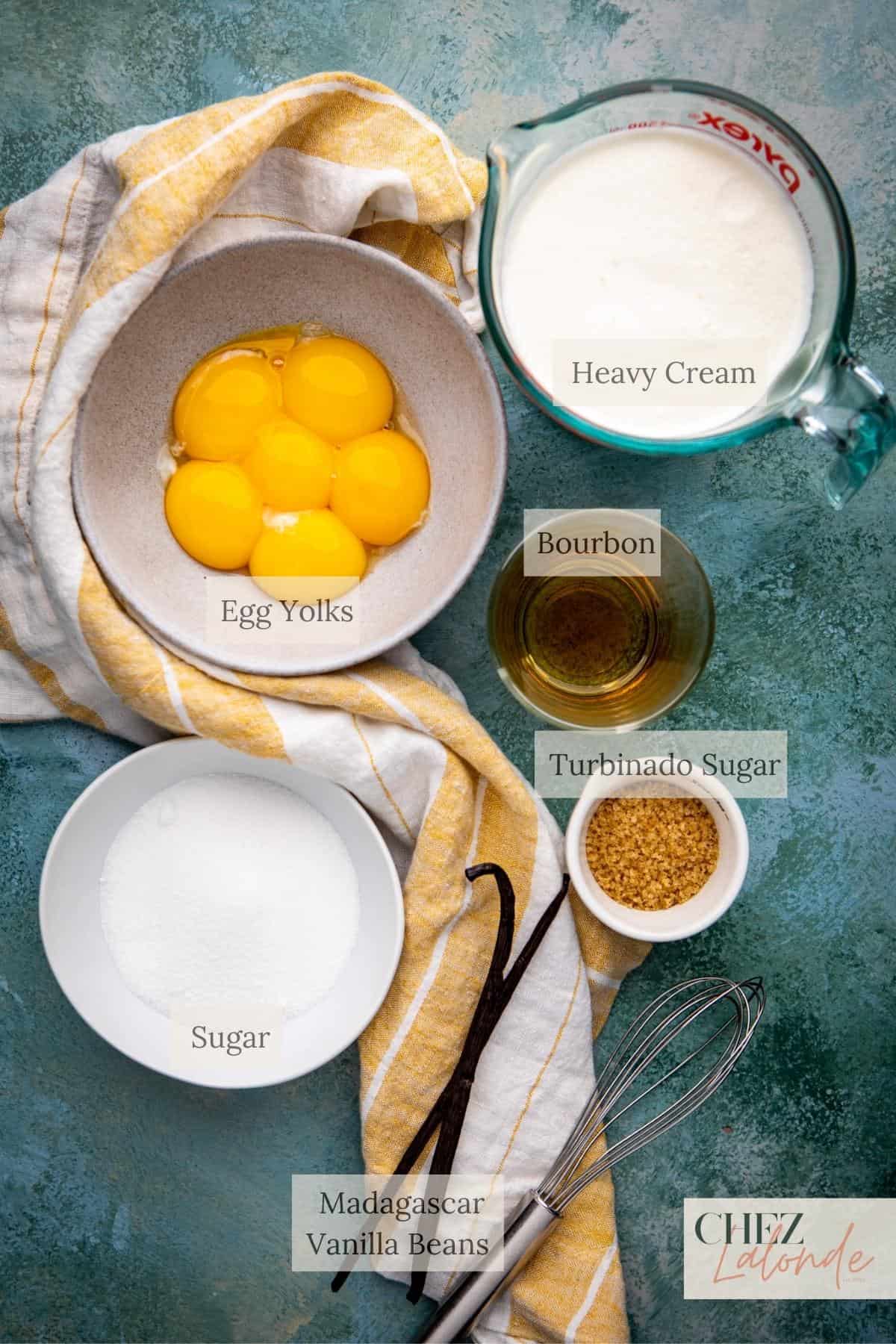
- Egg Yolks – They are the binding agent for this dessert and the star of the show, providing the rich, custardy texture that we all love.
- Granulated sugar – is added to sweeten the custard and to help it set properly.
- Heavy Cream – is used to create a velvety smooth texture and to give the dessert a luscious mouthfeel.
- Vanilla Bean – Adds a fragrant, sweet flavor that complements the creamy custard.
- Bourbon – Brings a rice and complex taste to the dessert. The oaky notes create a deep, warm, and slightly sweet undertone that compliments the creamy custard beautifully.
- Turbinado Sugar – The coarse texture and subtle molasses flavor provide the perfect balance of sweetness and caramelization, a satisfyingly crunchy and caramelized topping.
Recipe Substitutions and Variations:
- To reduce costs, vanilla extract can be used as a substitute for vanilla bean.
- If you prefer not to include alcohol in the dessert, you can omit the bourbon without affecting the outcome.
- On the other hand, if you’d like to experiment, you can substitute Bourbon with dark rum, Brandy, Amaretto, or Grand Marnier. These choices of liquor can add a unique twist to the classic profile.
- If you don’t have any Mason Jars, an alternative method is to place the custard mixture in a Ziploc bag and cook it using the same technique. Once cooked, transfer the custard into individual ramekins and refrigerate for a few hours until fully set.
A step-by-step guide on how to make this spectacular French dessert:
Preparing the custard and vanilla bean:
Step 1: Use a pairing knife to slit the vanilla bean lengthwise. Then, delicately scrape out the flavorful beans using the back of the blade.
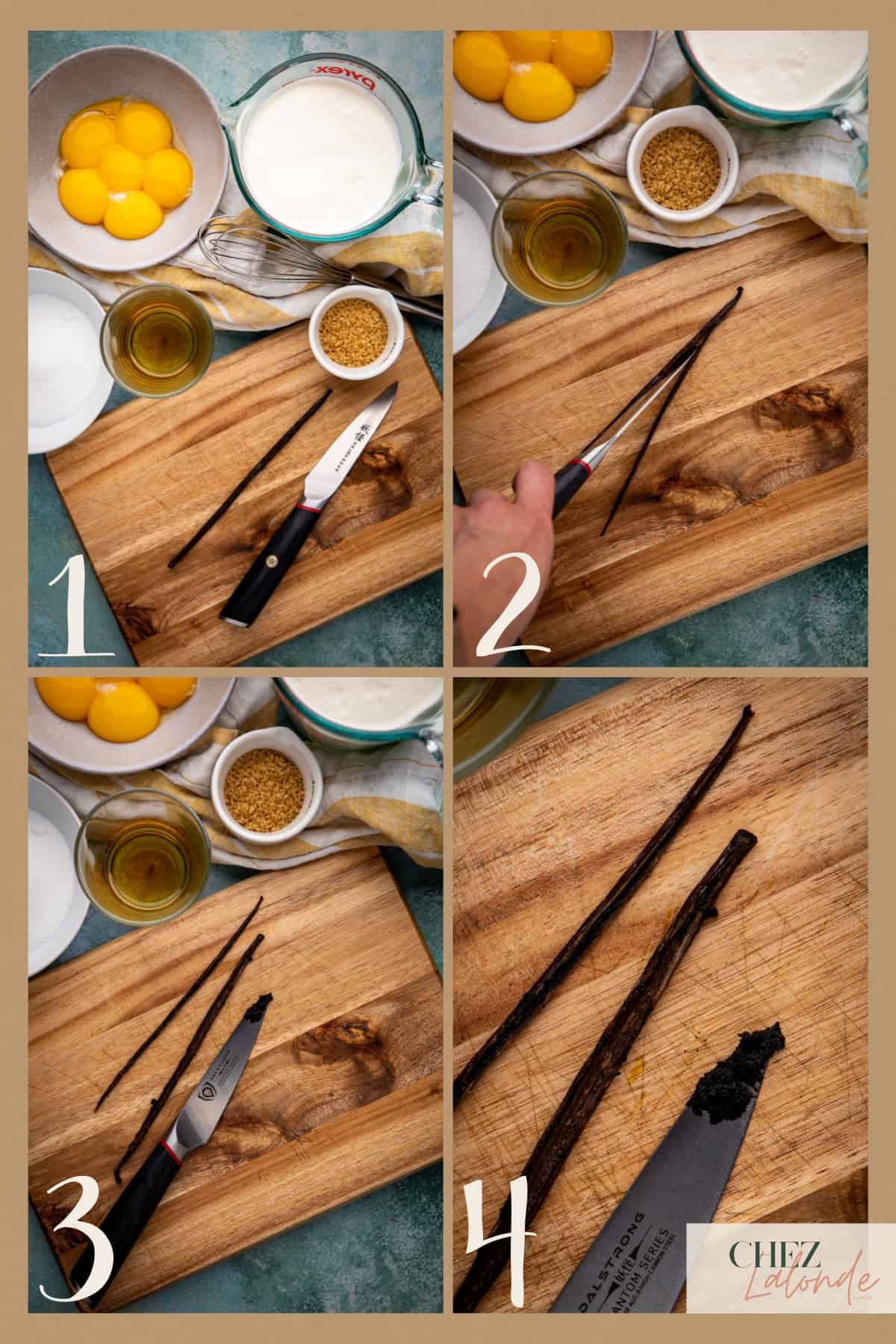
Step 2: In a large bowl, whisk together the egg yolks, granulated sugar, vanilla bean paste (or vanilla extract), Bourbon (if using/ or another choice of liquor), and heavy cream until well combined.
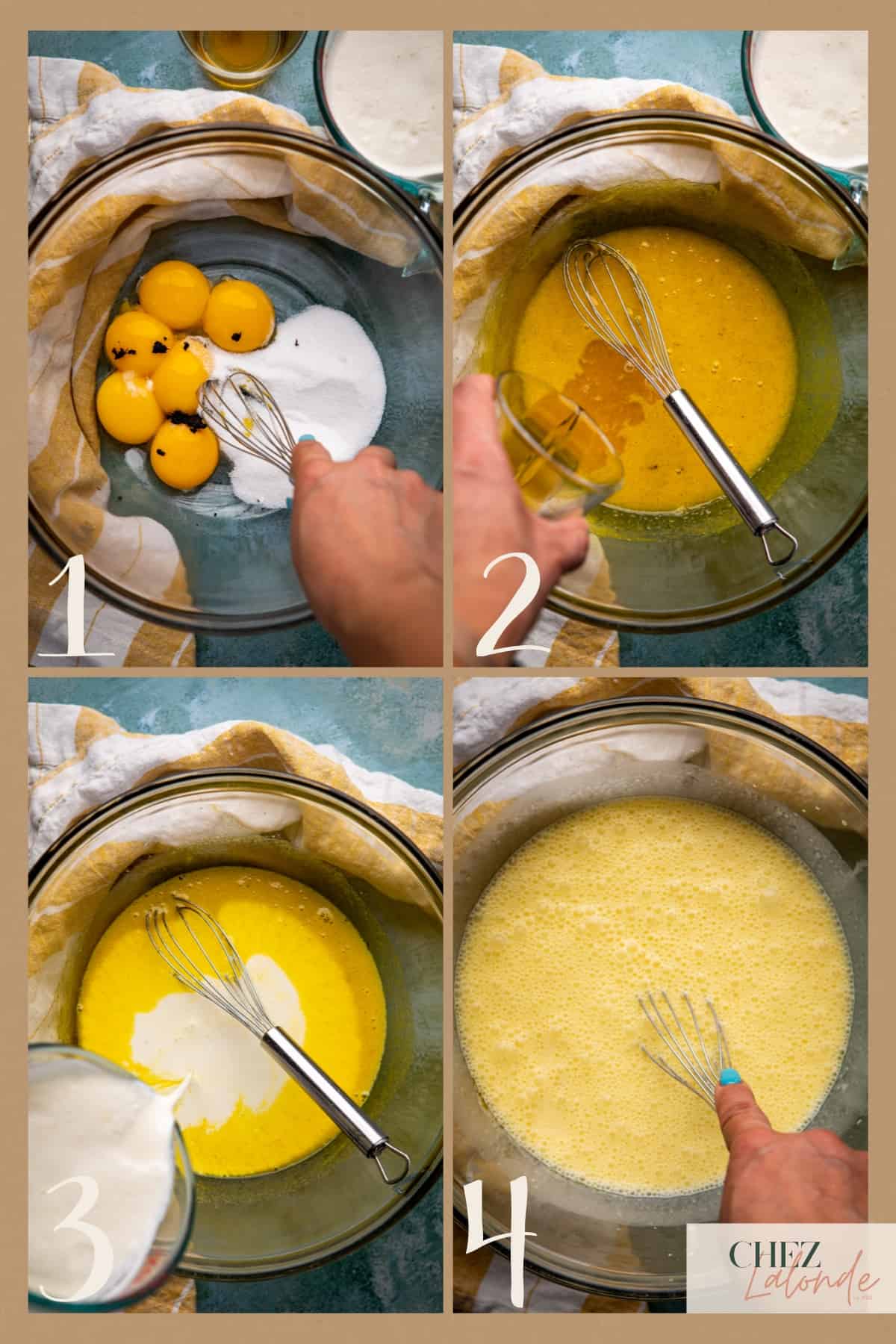
Step 3: Evenly distribute the custard mixture among the individual 12oz wide-mouth Mason jars, ensuring not to fill them to the brim. Leave some space for the mixture to expand as it cooks.

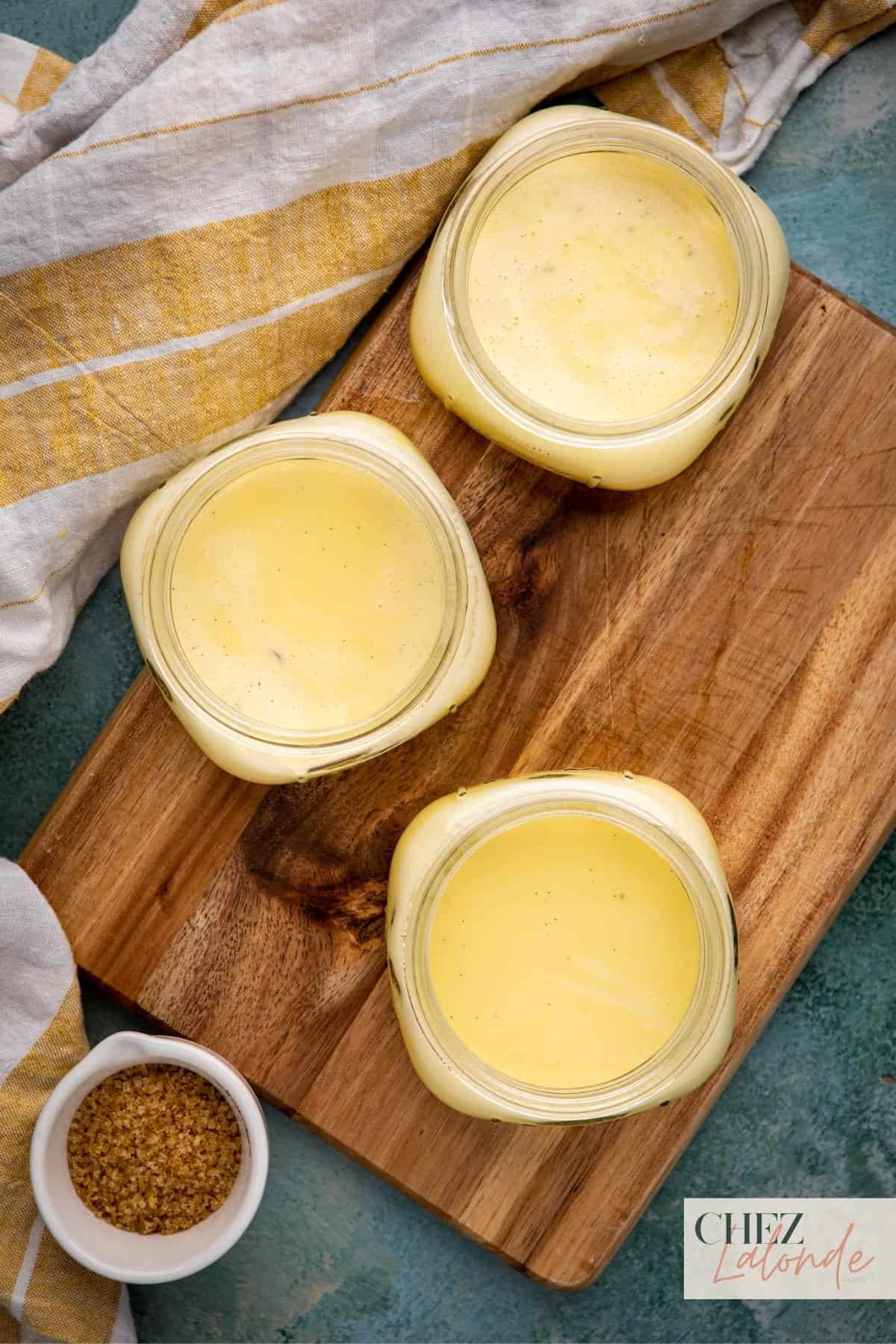
Begin with Sous Vide Cooking:
Step 4: Fill a large pot or Sous Vide container with cool water and submerge each jar carefully, ensuring they are fully immersed. It’s important to use cool water to prevent thermal shock and potential cracking of the jars. Also, remember to tighten the lids only fingertip to avoid excessive pressure that could cause the Mason jars to crack.
Step 5: Once all the jars are placed inside the pot or container, you can turn on the Sous Vide immersion circulator. Set the temperature to 180°F/82°C and allow the machine approximately 10 to 15 minutes to reach the desired temperature.


Step 6: Once the set temperature is reached, allow the custard to cook undisturbed for precisely one hour and fifteen minutes. The beauty of Sous Vide cooking is that you don’t need to monitor it constantly. Feel free to leave the house and attend to your other tasks while the custard cooks to perfection.
Chilling and setting the custard:
Step 7: Once cooked, use jar lifter tongs to remove the jars from the water bath carefully. Allow the custard to cool on the kitchen counter until it reaches room temperature. Then, refrigerate the jars for at least 4 to 6 hours, ideally overnight, to allow the custard to set perfectly.
Here comes the fun Brûlée time, carmelizing the sugar:
Step 8: Just before serving, sprinkle a thin, even layer of turbinado sugar on top of each custard.
Step 9: Using a kitchen torch, caramelize the sugar by moving the flame in a circular motion until it melts and turns golden brown. Be cautious and ensure even browning.
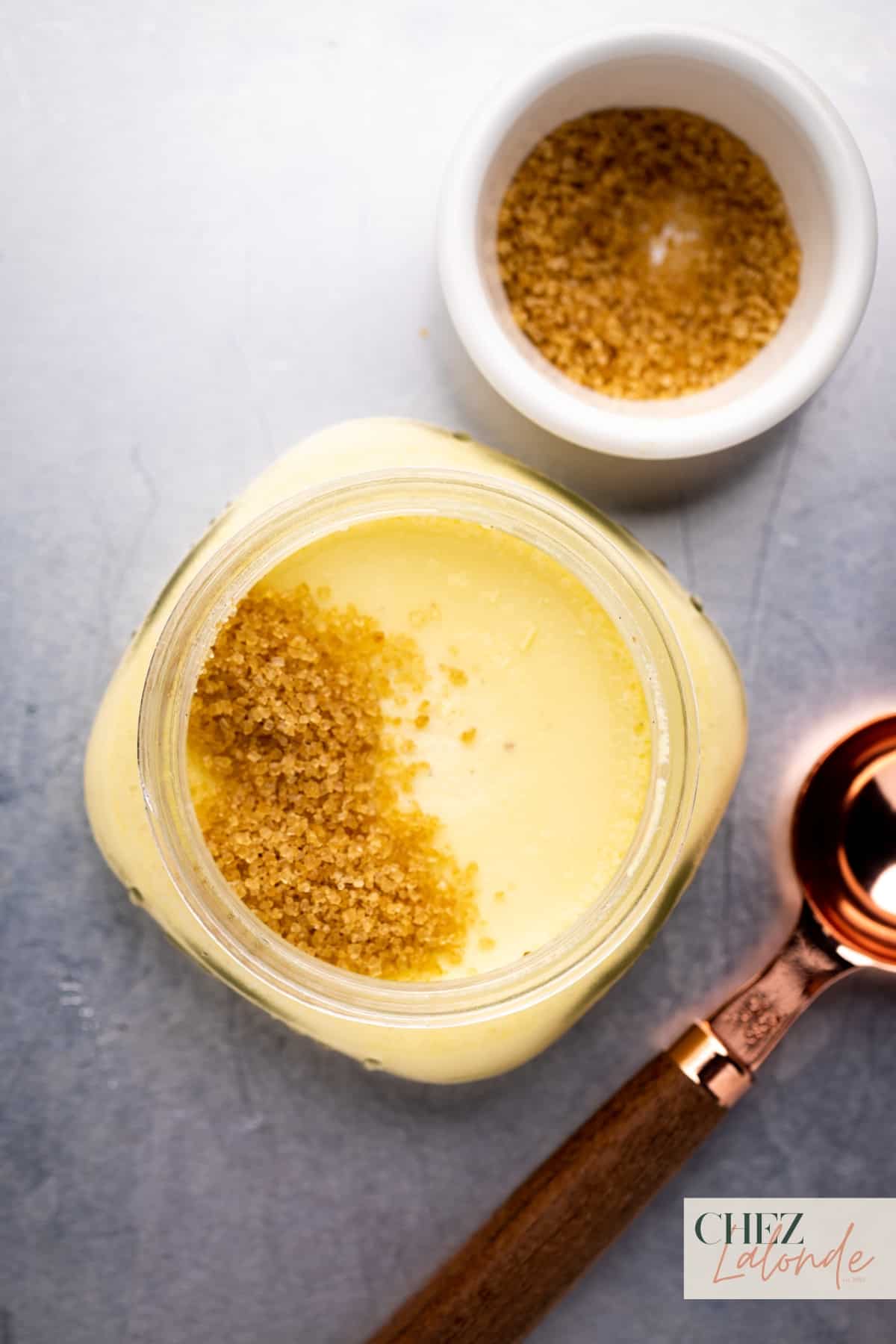
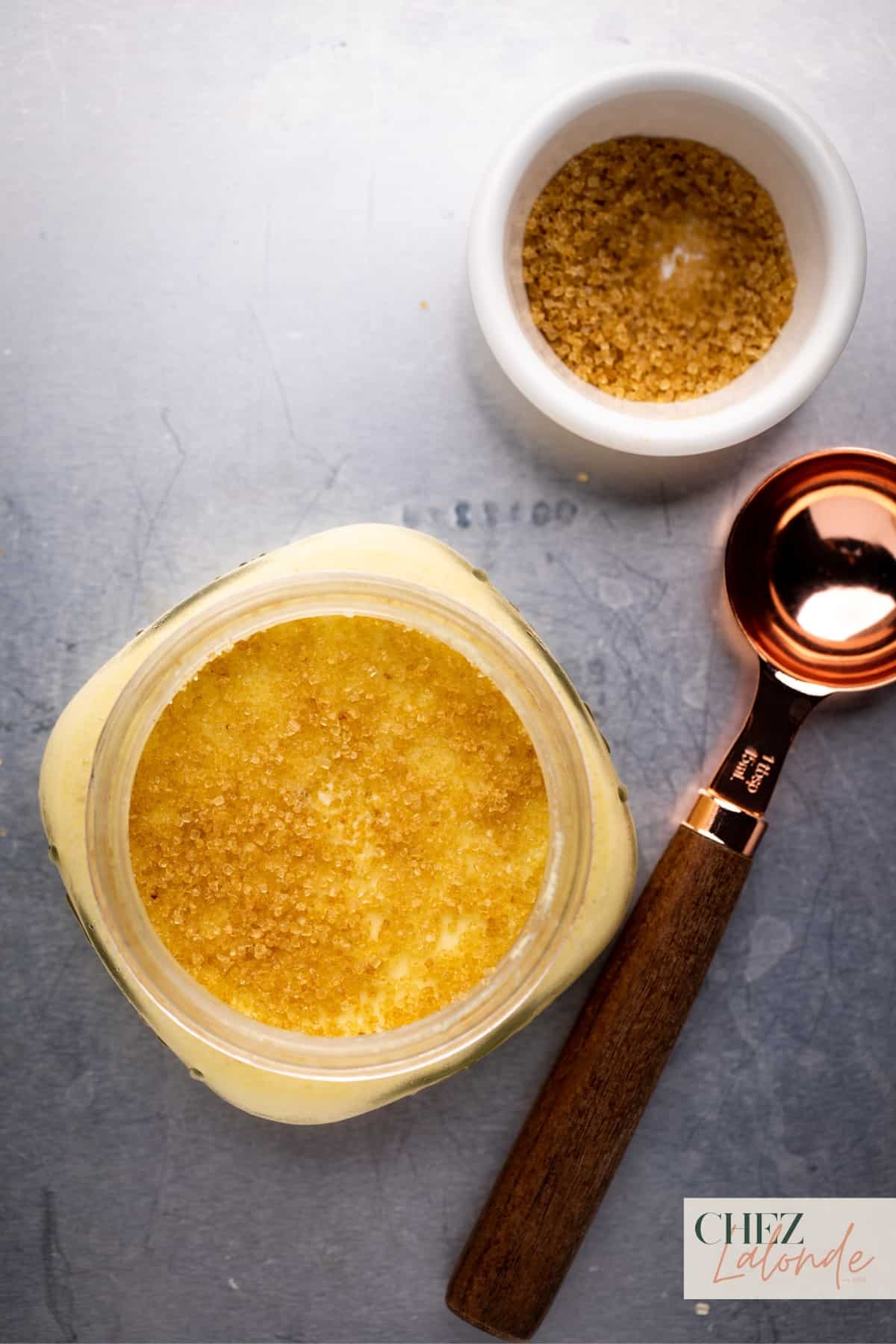

Serving and Enjoy:
Step 10: Let the custards sit for a few minutes to allow the caramelized sugar to harden. Garnish with fresh berries or a dollop of whipped cream. You can immediately savor this indulgent dessert.

Recipe Tips And Tricks
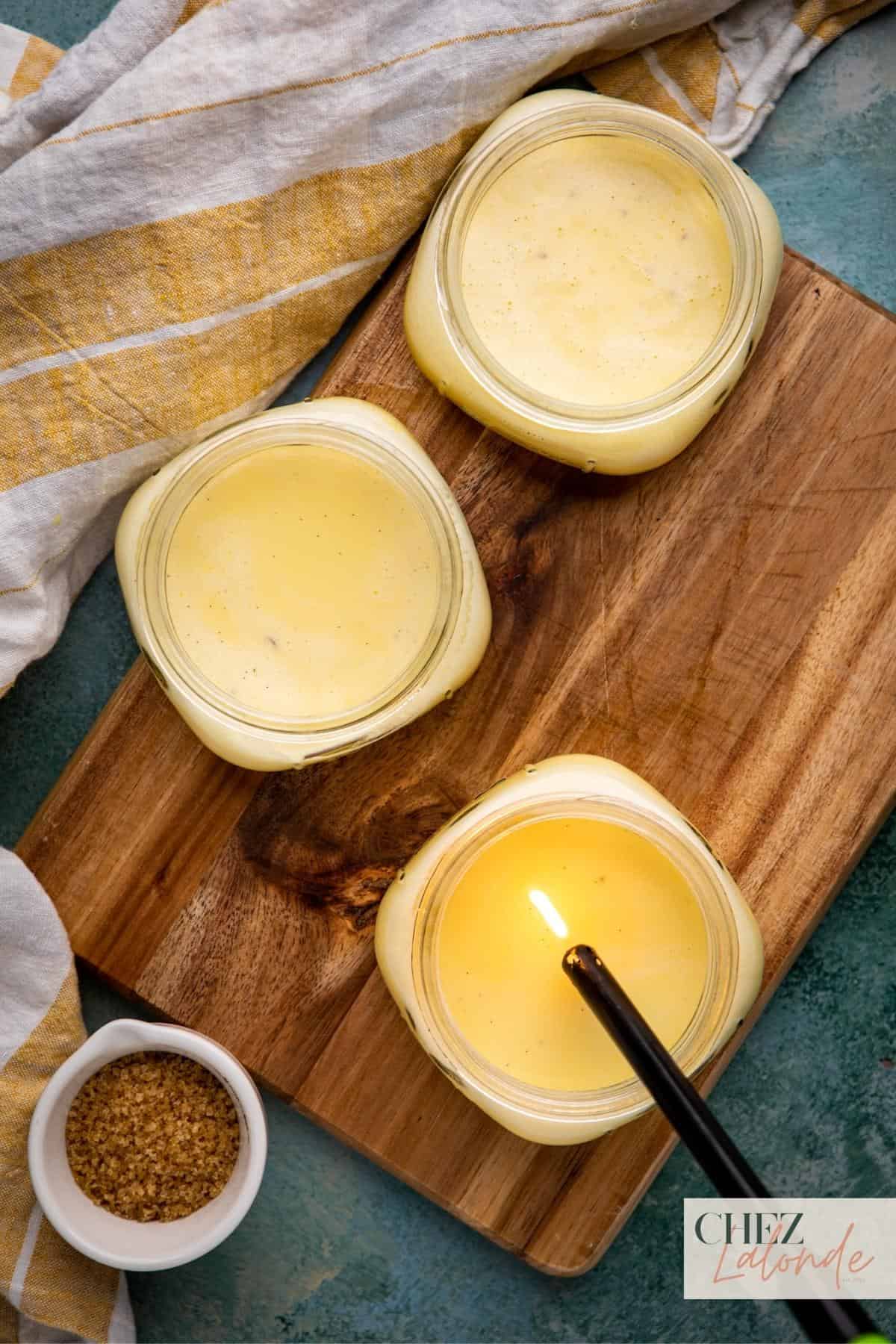
A Trick to Achieve a silky smooth custard surface:
You can use a lighter to eliminate any air bubbles on the top swiftly. Avoid removing them individually with a fork or toothpick, as it can be time-consuming. The trick is to use a lighter, which allows you to remove all the bubbles in seconds. By doing so, your creme brulee will boast a professionally done appearance akin to five-star restaurants.
Experiment with flavor variations:
- While classic vanilla is delicious, don’t be afraid to experiment with different flavors. You can infuse the custard base with ingredients like coffee, citrus zest, or spices to add unique twists to your Sous Vide crème brûlée. Get creative and discover new flavor combinations that suit your taste preferences. Here are some other seasonal ingredients that can be used to make delicious variations of Sous Vide crème brûlée:
- Winter: Peppermint or almond extract and dark chocolate shavings.
- Spring: Lemon zest, culinary lavender, or fresh herbs like thyme or rosemary
- Summer: Fresh berries, whipped cream, or a scoop of vanilla ice cream.
- Fall: Pumpkin puree, cinnamon, nutmeg, or ginger juice.
Allow the custard to cool before refrigerating:
After removing the jars from the water bath, let them cool to room temperature on the kitchen counter. This gradual cooling process helps to prevent condensation from forming on the custard’s surface, ensuring a pristine presentation when it’s time to serve.
Storage Tips
Once cooled to room temperature, store this jar-made dessert in the refrigerator. It can be kept for 3 to 5 days. Remember, if you don’t plan to consume it immediately, refrain from adding the caramelized sugar layer. Save that step for when you’re ready to enjoy it. Preparing the sugar layer in advance and refrigerating it will cause it to melt, resulting in a loss of the desired “Brûlée” effect.

FAQs about Sous Vide Crème Brûlée
This dessert will pair perfectly with these entrées:
Conclusion:
To conclude, I invite you to indulge in the exquisite combination of flavors and textures in our Sous Vide Vanilla and Bourbon Crème Brûlée. This dessert seamlessly marries the sophistication of a classic French delicacy with the precise science of sous vide cooking. Every bite offers a moment of pure decadence, from the velvety smooth custard infused with vanilla and bourbon to the irresistibly caramelized sugar crust. Make it this week and treat yourself and your loved ones to this delightful creation.

Bon appétit
Ready to explore more delicious recipes and culinary adventures? Don’t miss out on future mouthwatering creations! Follow my blog to stay updated with the latest recipes, cooking tips, and food inspiration.

Sous Vide Bourbon Vanilla Crème Brûlée In Mason Jars
- Total Time: 0 hours
- Yield: 4
Description
Indulge in the luxurious flavors of Sous Vide Bourbon Vanilla crème brûlée in Mason jars—silky-smooth custard infused with the rich essence of bourbon, topped with a caramelized sugar crust. A delightful twist on a classic French dessert, perfectly cooked using the Sous Vide technique. Try this elegant and decadent treat today!
Ingredients
To make the custard:
6 large egg yolks
1/3 cups of sugar
2 cups of heavy cream
1 fresh vanilla bean (Or 2 teaspoons of vanilla extract)
2 Tablespoons of Bourbon (Optional)
To make the caramelized crust
2 Tablespoons of Turbinado sugar (Adjust the quantity as needed)
Instructions
Preparing the Custard and vanilla bean:
Step 1: Use a paring knife to slit the vanilla bean lengthwise. Then, delicately scrape out the flavorful beans using the back of the blade.
Step 2: In a large bowl, whisk together the egg yolks, heavy cream, granulated sugar, vanilla bean paste (or extract), and bourbon (if using/ or another choice of liquor) until well combined.
Step 3: Evenly distribute the custard mixture among the individual Mason jars, ensuring not to fill them to the brim. Leave some space for the mixture to expand as it cooks.
Begin with Sous Vide Cooking:
Step 4: Fill a large pot or Sous Vide container with cool water and submerge each jar carefully, ensuring they are fully immersed. It’s important to use cool water to prevent thermal shock and potential cracking of the jars. Also, remember to tighten the lids only fingertip to avoid excessive pressure that could cause the Mason jars to crack.
Step 5: Once all the jars are placed inside the pot or container, you can turn on the Sous Vide immersion circulator. Set the temperature to 180°F/82°C and allow the machine approximately 10 to 15 minutes to reach the desired temperature.
Step 6: Once the set temperature is reached, allow the custard to cook undisturbed for precisely one hour and fifteen minutes. The beauty of Sous Vide cooking is that you don’t need to monitor it constantly. Feel free to leave the house and attend to your other tasks while the custard cooks to perfection.
Chilling and setting:
Step 7: Once cooked, use jar lifter tongs to remove the jars from the water bath carefully. Allow the custard to cool on the kitchen counter until it reaches room temperature. Then, refrigerate the jars for at least 4 to 6 hours, ideally overnight, to allow the custard to set perfectly.
Here comes the fun Brûlée time, caramelizing the sugar:
Step 8: Just before serving, sprinkle a thin, even layer of turbinado sugar on top of each custard.
Step 9: Using a blow torch or kitchen torch, caramelize the sugar by moving the flame in a circular motion until it melts and turns golden brown. Be cautious and ensure even browning.
Serving and Enjoy:
Step 10: Let the custards sit for a few minutes to allow the caramelized sugar to harden. Garnish with fresh berries or a dollop of whipped cream. You can immediately savor this indulgent dessert.
Notes
The ideal time to torch your Crème Brûlée is before serving, as the caramelized sugar crust can melt in hot weather or stored in the fridge.
Always use a kitchen torch to caramelize the sugar crust, and never use an oven broiler because it will overcook the custard.
- Prep Time: 20 minutes
- Cook Time: 1 hour and 15 minutes
- Category: Desserts
- Method: Sous Vide
- Cuisine: Italian


